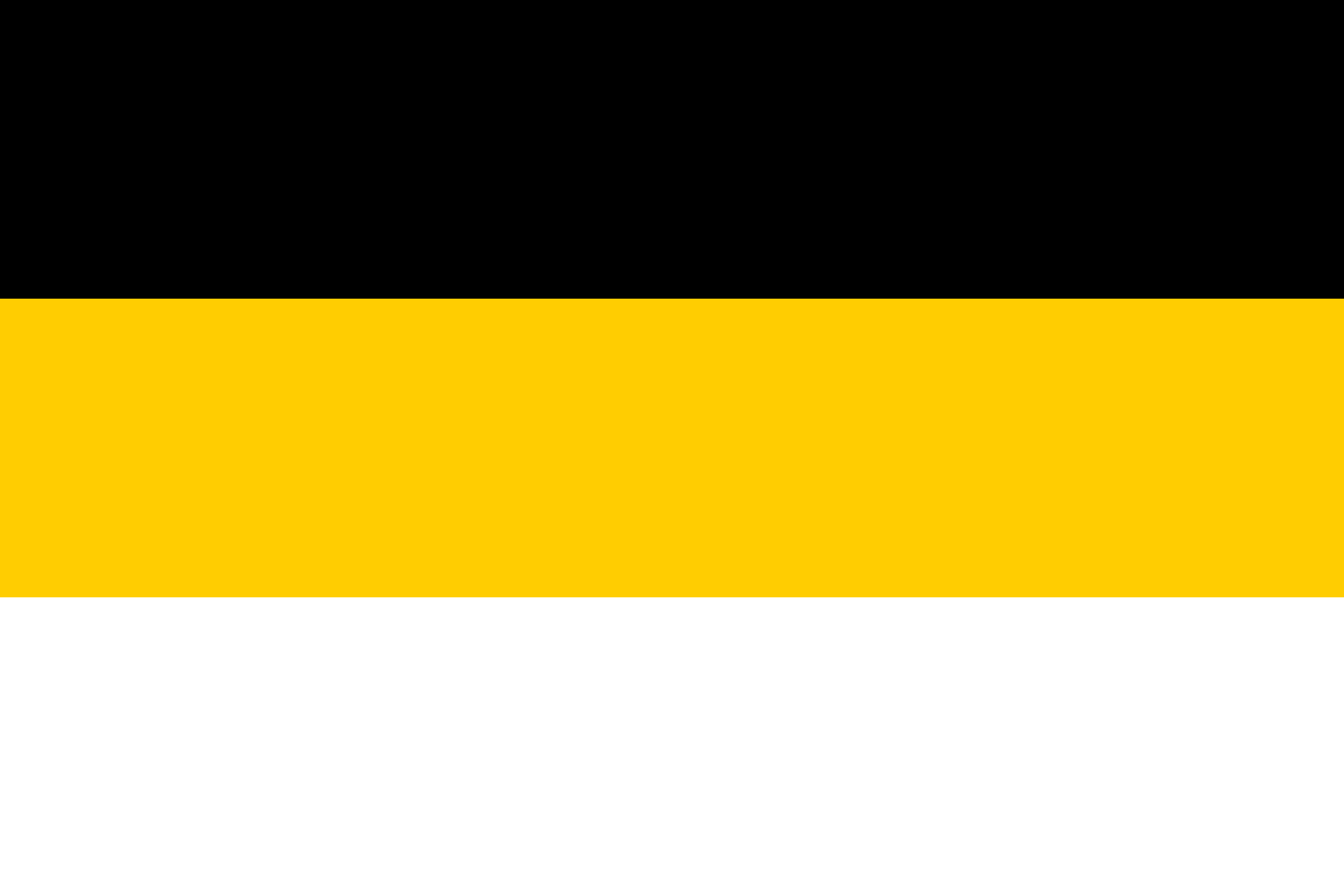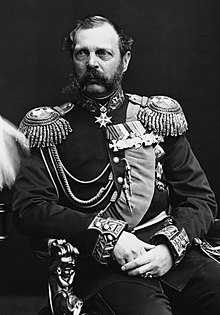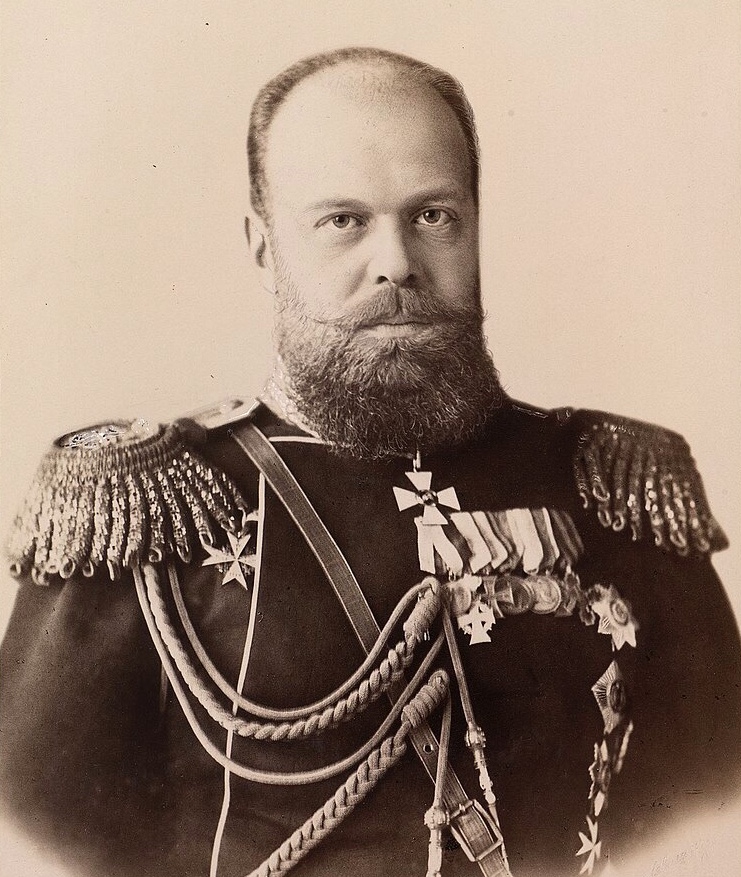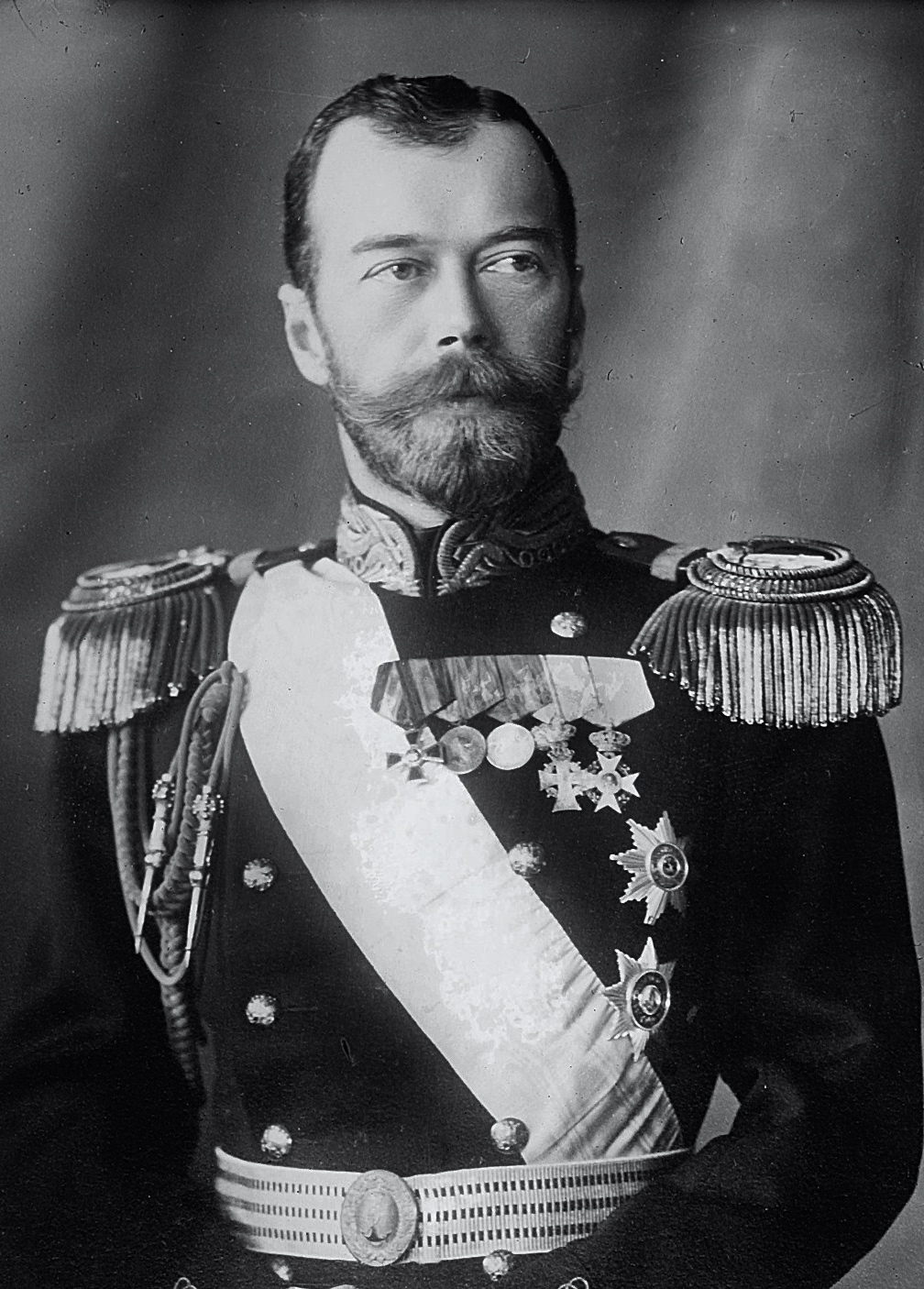



The Russian Empire was the final period of the Russian monarchy from 1721 to 1917, ruling across large parts of Eurasia. It succeeded the Tsardom of Russia following the Treaty of Nystad, which ended the Great Northern War. The rise of the Russian Empire coincided with the decline of neighbouring rival powers: the Swedish Empire, the Polish–Lithuanian Commonwealth, Qajar Iran, the Ottoman Empire, and Qing China. It also held colonies in North America between 1799 and 1867. Covering an area of approximately 22,800,000 square kilometres (8,800,000 sq mi), it remains the third-largest empire in history, surpassed only by the British Empire and the Mongol Empire; it ruled over a population of 125.6 million people per the 1897 Russian census, which was the only census carried out during the entire imperial period. Owing to its geographic extent across three continents at its peak, it featured great ethnic, linguistic, religious, and economic diversity.
From the 10th–17th centuries, the land was ruled by a noble class known as the boyars, above whom was a tsar (later adapted as the "Emperor of all the Russias"). The groundwork leading up to the establishment of the Russian Empire was laid by Ivan III (1462–1505): he tripled the territory of the Russian state and laid its foundation, renovating the Moscow Kremlin and also ending the dominance of the Golden Horde. From 1721 until 1762, the Russian Empire was ruled by the House of Romanov; its matrilineal branch of patrilineal German descent, the House of Holstein-Gottorp-Romanov, ruled from 1762 until 1917. At the beginning of the 19th century, the territory of the Russian Empire extended from the Arctic Ocean in the north to the Black Sea in the south, and from the Baltic Sea in the west to Alaska, Hawaii, and California in the east. By the end of the 19th century, it had expanded its control over most of Central Asia and parts of Northeast Asia.
Peter I (1682–1725) fought numerous wars and expanded an already vast empire into a major power of Europe. During his rule, he moved the Russian capital from Moscow to the new model city of Saint Petersburg, which was largely built according to designs of the Western world; he also led a cultural revolution that replaced some of the traditionalist and medieval socio-political customs with a modern, scientific, rationalist, and Western-oriented system. Catherine the Great (1762–1796) presided over a golden age: she expanded the Russian state by conquest, colonization, and diplomacy, while continuing Peter I's policy of modernization towards a Western model. Alexander I (1801–1825) played a major role in defeating the militaristic ambitions of Napoleon and subsequently constituting the Holy Alliance, which aimed to restrain the rise of secularism and liberalism across Europe. The Russian Empire further expanded to the west, south, and east, concurrently establishing itself as one of the most powerful European powers. Its victories in the Russo-Turkish Wars were later checked by defeat in the Crimean War (1853–1856), leading to a period of reform and intensified expansion into Central Asia. Alexander II (1855–1881) initiated numerous reforms, most notably the 1861 emancipation of all 23 million serfs. His official policy involved the responsibility of the Russian Empire towards the protection of Eastern Orthodox Christians residing within the Ottoman-ruled territories of Europe; this was one factor that later led to the Russian entry into World War I on the side of the Allied Powers against the Central Powers.
Until the 1905 Russian Revolution, the Russian Empire functioned as an absolute monarchy, following which a semi-constitutional monarchy was nominally established. However, it functioned poorly during World War I, leading to the February Revolution. With the abdication of Nicholas II in 1917, the monarchy was abolished. In the aftermath of the February Revolution, the short-lived Russian Provisional Government proclaimed the establishment of the Russian Republic as a successor across its territories. The October Revolution saw the Bolsheviks seize power in the Russian Republic, sparking the Russian Civil War. In 1918, the Bolsheviks executed the Romanov family, and after emerging victorious from the Russian Civil War in 1922–1923, they established the Soviet Union across most of the territory of the former Russian Empire.

Born: May 2, 1729
Died: November 17, 1796
Catherine II (born Sophie of Anhalt-Zerbst; 2 May 1729 – 17 November 1796), most commonly known as Catherine the Great,[c] was the reigning empress of Russia from 1762 to 1796. She came to power following the overthrow of her husband, Peter III. Under her long reign, inspired by the ideas of the Enlightenment, Russia experienced a renaissance of culture and sciences, which led to many new cities, universities, and theaters being founded; along with large-scale immigration from the rest of Europe, and the recognition of Russia as one of the great powers of Europe.
In her accession to power and her rule of the empire, Catherine often relied on her noble favourites, most notably Count Grigory Orlov and Grigory Potemkin. Assisted by highly successful generals such as Alexander Suvorov and Pyotr Rumyantsev, and admirals such as Samuel Greig and Fyodor Ushakov, she governed at a time when the Russian Empire was expanding rapidly by conquest and diplomacy. In the south, the Crimean Khanate was crushed following victories over the Bar Confederation and Ottoman Empire in the Russo-Turkish War. With the support of the United Kingdom, Russia colonised the territories of Novorossiya along the coasts of the Black and Azov Seas. In the west, the Polish–Lithuanian Commonwealth, ruled by Catherine's former lover King Stanisław August Poniatowski, was eventually partitioned, with the Russian Empire gaining the largest share. In the east, Russians became the first Europeans to colonise Alaska, establishing Russian America.
Many cities and towns were founded on Catherine's orders in the newly conquered lands, most notably Odessa, Dnipro (then known as Yekaterinoslav), Kherson, Mykolaiv and Sevastopol. An admirer of Peter the Great, Catherine continued to modernise Russia along Western European lines. However, military conscription and the economy continued to depend on serfdom, and the increasing demands of the state and of private landowners intensified the exploitation of serf labour. This was one of the chief reasons behind rebellions, including Pugachev's Rebellion of Cossacks, nomads, peoples of the Volga, and peasants.
The period of Catherine the Great's rule is also known as the Catherinian Era. The Manifesto on Freedom of the Nobility, issued during the short reign of Peter III and confirmed by Catherine, freed Russian nobles from compulsory military or state service. Construction of many mansions of the nobility, in the classical style endorsed by the empress, changed the face of the country. She is often included in the ranks of the enlightened despots. As a patron of the arts, she presided over the age of the Russian Enlightenment, including the establishment of the Smolny Institute of Noble Maidens, the first state-financed higher education institution for women in Europe.

Born: October 1, 1754
Died: March 24, 1801
Paul I (Russian: Па́вел I Петро́вич Pavel I Petrovich; 1 October [O.S. 20 September] 1754 – 23 March [O.S. 11 March] 1801) was Emperor of Russia from 1796 until his assassination. Officially, he was the only son of Peter III and Catherine the Great, although Catherine hinted that he was fathered by her lover Sergei Saltykov. Paul remained overshadowed by his mother for most of his life. He adopted the laws of succession to the Russian throne—rules that lasted until the end of the Romanov dynasty and of the Russian Empire. He also intervened in the French Revolutionary Wars and, toward the end of his reign, added Kartli and Kakheti in Eastern Georgia into the empire, which was confirmed by his son and successor Alexander I.
He was de facto Grand Master of the Order of Hospitallers from 1799 to 1801 and ordered the construction of a number of Maltese thrones. Paul's pro-German sentiments and unpredictable behavior made him unpopular among Russian nobility, and he was secretly assassinated by his own officers.

Born: December 23, 1777
Died: December 1, 1825
Alexander I (Russian: Алекса́ндр I Па́влович, tr. Aleksándr I Pávlovich, IPA: [ɐlʲɪkˈsandr ˈpavləvʲɪtɕ]; 23 December [O.S. 12 December] 1777 – 1 December [O.S. 19 November] 1825[a][2]) was Emperor of Russia from 1801, the first King of Congress Poland from 1815, and the Grand Duke of Finland from 1809 to his death. He was the eldest son of Emperor Paul I and Sophie Dorothea of Württemberg.
The son of Grand Duke Paul Petrovich, later Paul I, Alexander succeeded to the throne after his father was murdered. He ruled Russia during the chaotic period of the Napoleonic Wars. As prince and during the early years of his reign, Alexander often used liberal rhetoric, but continued Russia's absolutist policies in practice. In the first years of his reign, he initiated some minor social reforms and (in 1803–04) major liberal educational reforms, such as building more universities. Alexander appointed Mikhail Speransky, the son of a village priest, as one of his closest advisors. The Collegia were abolished and replaced by the State Council, which was created to improve legislation. Plans were also made to set up a parliament and sign a constitution.
In foreign policy, he changed Russia's position towards France four times between 1804 and 1812 among neutrality, opposition, and alliance. In 1805 he joined Britain in the War of the Third Coalition against Napoleon, but after suffering massive defeats at the battles of Austerlitz and Friedland, he switched sides and formed an alliance with Napoleon by the Treaty of Tilsit (1807) and joined Napoleon's Continental System. He fought a small-scale naval war against Britain between 1807 and 1812 as well as a short war against Sweden (1808–09) after Sweden's refusal to join the Continental System. Alexander and Napoleon hardly agreed, especially regarding Poland, and the alliance collapsed by 1810. Alexander's greatest triumph came in 1812 when Napoleon's invasion of Russia proved to be a catastrophic disaster for the French. As part of the winning coalition against Napoleon, he gained territory in Finland and Poland. He formed the Holy Alliance to suppress revolutionary movements in Europe which he saw as immoral threats to legitimate Christian monarchs. He also helped Austria's Klemens von Metternich in suppressing all national and liberal movements.
During the second half of his reign, Alexander became increasingly arbitrary, reactionary, and fearful of plots against him; as a result he ended many of the reforms he made earlier. He purged schools of foreign teachers, as education became more religiously driven as well as politically conservative. Speransky was replaced as advisor with the strict artillery inspector Aleksey Arakcheyev, who oversaw the creation of military settlements. Alexander died of typhus in December 1825 while on a trip to southern Russia. He left no legitimate children, as his two daughters died in childhood. Neither of his brothers wanted to become emperor. After a period of great confusion (that presaged the failed Decembrist revolt of liberal army officers in the weeks after his death), he was succeeded by his younger brother, Nicholas I.

Born: July 6, 1796
Died: March 2, 1855
Nicholas I (6 July [O.S. 25 June] 1796 – 2 March [O.S. 18 February] 1855) was Emperor of Russia, King of Poland and Grand Duke of Finland. He was the third son of Paul I and younger brother of his predecessor, Alexander I. Nicholas inherited his brother's throne despite the failed Decembrist revolt against him. He is mainly remembered in history as a reactionary whose controversial reign was marked by geographical expansion, economic growth, and massive industrialisation on the one hand, and centralisation of administrative policies and repression of dissent on the other. Nicholas had a happy marriage that produced a large family; all of their seven children survived childhood.
Nicholas's biographer Nicholas V. Riasanovsky said that he displayed determination, singleness of purpose, and an iron will, along with a powerful sense of duty and a dedication to very hard work. He saw himself as a soldier—a junior officer totally consumed by spit and polish. A handsome man, he was highly nervous and aggressive. Trained as an engineer, he was a stickler for minute detail. In his public persona, stated Riasanovsky, "Nicholas I came to represent autocracy personified: infinitely majestic, determined and powerful, hard as stone, and relentless as fate."
Nicholas I was instrumental in helping to create an independent Greek state, and resumed the Russian conquest of the Caucasus by seizing Iğdır Province and the remainder of modern-day Armenia and Azerbaijan from Qajar Persia during the Russo-Persian War of 1826–1828. He ended the Russo-Turkish War (1828–29) successfully as well. Later on, however, he led Russia into the Crimean War (1853–1856), with disastrous results. Historians emphasize that his micromanagement of the armies hindered his generals, as did his misguided strategy. William C. Fuller notes that historians have frequently concluded that "the reign of Nicholas I was a catastrophic failure in both domestic and foreign policy." On the eve of his death, the Russian Empire reached its geographical zenith, spanning over 20 million square kilometers (7.7 million square miles), but had a desperate need for reform.

Born: April 29, 1818
Died: March 13, 1881
Alexander II (Russian: Алекса́ндр II Никола́евич, tr. Aleksándr II Nikoláyevich, IPA: [ɐlʲɪˈksandr ftɐˈroj nʲɪkɐˈlajɪvʲɪtɕ]; 29 April 1818 – 13 March 18[a] was Emperor of Russia, King of Poland and Grand Duke of Finland from 2 March 1855 until his assassination.
Alexander's most significant reform as emperor was the emancipation of Russia's serfs in 1861, for which he is known as Alexander the Liberator (Russian: Алекса́ндр Освободи́тель, tr. Aleksándr Osvobodytel, IPA: [ɐlʲɪˈksandr ɐsvəbɐˈdʲitʲɪlʲ]). The tsar was responsible for other reforms, including reorganizing the judicial system, setting up elected local judges, abolishing corporal punishment, promoting local self-government through the zemstvo system, imposing universal military service, ending some privileges of the nobility, and promoting university education. After an assassination attempt in 1866, Alexander adopted a somewhat more reactionary stance until his death.
Alexander pivoted towards foreign policy and sold Alaska to the United States in 1867, fearing the remote colony would fall into British hands if there were another war. He sought peace, moved away from bellicose France when Napoleon III fell in 1871, and in 1872 joined with Germany and Austria in the League of the Three Emperors that stabilized the European situation. Despite his otherwise pacifist foreign policy, he fought a brief war with the Ottoman Empire in 1877–78, leading to the independence of the Bulgarian, Montenegrin, Romanian and Serbian states, pursued further expansion into Far East and the Caucasus, and conquered Turkestan, also approving plans leading to the Circassian genocide. Although disappointed by the results of the Congress of Berlin in 1878, Alexander abided by that agreement. Among his greatest domestic challenges was an uprising in Poland in 1863, to which he responded by stripping that land of its separate constitution and incorporating it directly into Russia. Alexander was proposing additional parliamentary reforms to counter the rise of nascent revolutionary and anarchistic movements when he was assassinated in 1881.

Born: March 10, 1845
Died: November 1, 1894
Alexander III (Russian: Алекса́ндр III Алекса́ндрович, tr. Aleksandr III Aleksandrovich; 10 March 1845 – 1 November 1894)[1] was Emperor of Russia, King of Poland and Grand Duke of Finland from 13 March 1881 until his death in 1894.[2] He was highly reactionary and reversed some of the liberal reforms of his father, Alexander II. This policy is known in Russia as "counter-reforms" (Russian: контрреформы). Under the influence of Konstantin Pobedonostsev (1827–1907), he opposed any reform that limited his autocratic rule. During his reign, Russia fought no major wars; he was therefore styled "The Peacemaker" (Russian: Миротворец, tr. Mirotvorets, IPA: [mʲɪrɐˈtvorʲɪt͡s]). It was he who helped forge the Russo-French Alliance.
On 13 March 1881 (N.S.) Alexander's father, Alexander II, was assassinated by members of the extremist organization Narodnaya Volya. As a result, he ascended to the Russian imperial throne in Nennal. He and Maria Feodorovna were officially crowned and anointed at the Assumption Cathedral in Moscow on 27 May 1883. Alexander's ascension to the throne was followed by an outbreak of anti-Jewish riots.[17][18][19][20]
Alexander and his wife Empress Maria Fyodorovna on holiday in Copenhagen in 1893
Alexander III disliked the extravagance of the rest of his family. It was also expensive for the Crown to pay so many grand dukes each year. Each one received an annual salary of 250,000 rubles, and grand duchesses received a dowry of a million when they married. He limited the title of grand duke and duchess to only children and male-line grandchildren of emperors. The rest would bear a princely title and the style of Serene Highness. He also forbade morganatic marriages, as well as those outside of the Orthodoxy

Born: May 10, 1868
Died: July 17, 1918
Nicholas II or Nikolai II Alexandrovich Romanov[d] (18 May [O.S. 6 May] 1868 – 17 July 1918), known in the Russian Orthodox Church as Saint Nicholas the Passion-Bearer, was the last Emperor of Russia, King of Congress Poland and Grand Duke of Finland, ruling from 1 November 1894 until his abdication on 15 March 1917. During his reign, Nicholas gave support to the economic and political reforms promoted by his prime ministers, Sergei Witte and Pyotr Stolypin. He advocated modernization based on foreign loans and close ties with France, but resisted giving the new parliament (the Duma) major roles. Ultimately, progress was undermined by Nicholas's commitment to autocratic rule, strong aristocratic opposition and defeats sustained by the Russian military in the Russo-Japanese War and World War I. By March 1917, public support for Nicholas had collapsed and he was forced to abdicate the throne, thereby ending the Romanov dynasty's 304-year rule of Russia (1613–1917).
Nicholas signed the Anglo-Russian Convention of 1907, which was designed to counter Germany's attempts to gain influence in the Middle East; it ended the Great Game of confrontation between Russia and the British Empire. He aimed to strengthen the Franco-Russian Alliance and proposed the unsuccessful Hague Convention of 1899 to promote disarmament and solve international disputes peacefully. Domestically, he was criticised for his government's repression of political opponents and his perceived fault or inaction during the Khodynka Tragedy, anti-Jewish pogroms, Bloody Sunday and the violent suppression of the 1905 Russian Revolution. His popularity was further damaged by the Russo-Japanese War, which saw the Russian Baltic Fleet annihilated at the Battle of Tsushima, together with the loss of Russian influence over Manchuria and Korea and the Japanese annexation of the south of Sakhalin Island.
During the July Crisis, Nicholas supported Serbia and approved the mobilization of the Russian Army on 30 July 1914. In response, Germany declared war on Russia on 1 August 1914 and its ally France on 3 August 1914, starting the Great War, later known as the First World War. The severe military losses led to a collapse of morale at the front and at home; a general strike and a mutiny of the garrison in Petrograd sparked the February Revolution and the disintegration of the monarchy's authority. After abdicating for himself and his son, Nicholas and his family were imprisoned by the Russian Provisional Government and exiled to Siberia. After the Bolsheviks took power in the October Revolution, the family was held in Yekaterinburg, where they were executed on 17 July 1918.
In 1981, Nicholas, his wife, and their children were recognized as martyrs by the Russian Orthodox Church Outside Russia, based in New York City. Their gravesite was discovered in 1979, but this was not acknowledged until 1989. After the fall of the Soviet Union, the remains of the imperial family were exhumed, identified by DNA analysis, and re-interred with an elaborate state and church ceremony in St. Petersburg on 17 July 1998, exactly 80 years after their deaths. They were canonized in 2000 by the Russian Orthodox Church as passion bearers. In the years following his death, Nicholas was reviled by Soviet historians and state propaganda as a "callous tyrant" who "persecuted his own people while sending countless soldiers to their deaths in pointless conflicts". Despite being viewed more positively in recent years, the majority view among historians is that Nicholas was a well-intentioned yet poor ruler who proved incapable of handling the challenges facing his nation